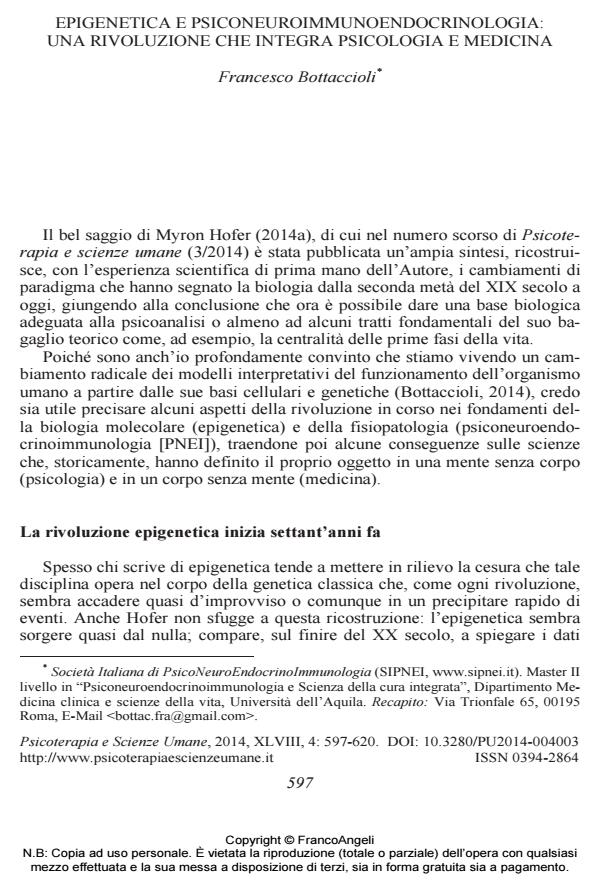Epigenetica e psiconeuroimmunoendocrinologia: una rivoluzione che integra psicologia e medicina
Titolo Rivista PSICOTERAPIA E SCIENZE UMANE
Autori/Curatori Francesco Bottaccioli
Anno di pubblicazione 2014 Fascicolo 2014/4
Lingua Italiano Numero pagine 24 P. 597-620 Dimensione file 106 KB
DOI 10.3280/PU2014-004003
Il DOI è il codice a barre della proprietà intellettuale: per saperne di più
clicca qui
Qui sotto puoi vedere in anteprima la prima pagina di questo articolo.
Se questo articolo ti interessa, lo puoi acquistare (e scaricare in formato pdf) seguendo le facili indicazioni per acquistare il download credit. Acquista Download Credits per scaricare questo Articolo in formato PDF

FrancoAngeli è membro della Publishers International Linking Association, Inc (PILA)associazione indipendente e non profit per facilitare (attraverso i servizi tecnologici implementati da CrossRef.org) l’accesso degli studiosi ai contenuti digitali nelle pubblicazioni professionali e scientifiche
Vengono ricostruite le principali caratteristiche della rivoluzione in corso nelle scienze della vita, e viene descritta la storia dell’epigenetica e il suo porsi come paradigma alternativo a quello dominante nell’ultimo mezzo secolo imperniato sul "dogma centrale della biologia molecolare". Vengono anche presentate le principali ricerche che legano le influenze ambientali alle modificazioni cellulari epigenetiche. Gli eventi mentali, consci e inconsci, possono tradursi in segnatura epigenetica, e ciò è possibile anche perché la psiconeuroendocrinoimmunologia (PNEI) ha dimostrato che la dimensione psichica comunica con quella biologica, influenzandosi reciprocamente. Da questa rivoluzione emerge una visione complessa dell’individuo e dei microsistemi vitali che spiega in modo non riduzionista sia il livello dell’organismo sia quello del genoma. È il superamento di una visione semplificata e frammentata dell’essere umano che consente di riorientare la ricerca e fondare su nuove basi la cura, integrando medicina e psicologia.
Parole chiave:Epigenetica, psiconeuroendocrinoimmunologia (PNEI), riduzionismo, nuova biologia, unità della conoscenza
- Come gli stati psichici si traducono in molecole biologiche e come questo cambia la medicina e la psicologia Anna Giulia Bottaccioli, Francesco Bottaccioli, in PSICOTERAPIA E SCIENZE UMANE 1/2023 pp.107
DOI: 10.3280/PU2023-001012
Francesco Bottaccioli, Epigenetica e psiconeuroimmunoendocrinologia: una rivoluzione che integra psicologia e medicina in "PSICOTERAPIA E SCIENZE UMANE" 4/2014, pp 597-620, DOI: 10.3280/PU2014-004003